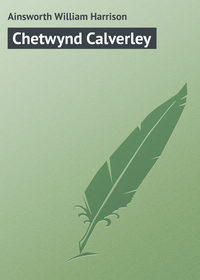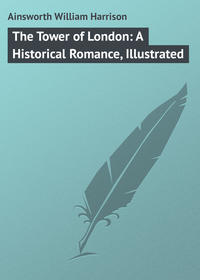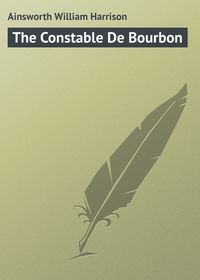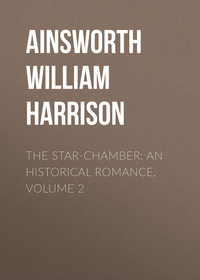 полная версия
полная версияRookwood

William Harrison Ainsworth
Rookwood
MEMOIR
William Harrison Ainsworth was born in King Street, Manchester, February 4, 1805, in a house that has long since been demolished. His father was a solicitor in good practice, and the son had all the advantages that educational facilities could afford. He was sent to the Manchester grammar-school, and in one of his early novels has left an interesting and accurate picture of its then condition, which may be contrasted with that of an earlier period left by the "English opium-eater." At sixteen, a brilliant, handsome youth, with more taste for romance and the drama than for the dry details of the law, he was articled to a leading solicitor of Manchester. The closest friend of his youth was a Mr. James Crossley, who was some years older, but shared his intellectual taste and literary enthusiasm. A drama written for private theatricals, in his father's house was printed in Arliss's Magazine, and he also contributed to the Manchester Iris, the Edinburgh Magazine, and the London Magazine. He even started a periodical, which received the name of The Bœotian, and died at the sixth number. Many of the fugitive pieces of these early days were collected in volumes now exceedingly rare: "December Tales" (London, 1823), which is not wholly from his pen; the "Works of Cheviot Tichburn" (London, 1822; Manchester, 1825), dedicated to Charles Lamb; and "A Summer Evening Tale" (London, 1825).
"Sir John Chiverton" appeared in 1826, and for forty years was regarded as one of his early works; but Mr. John Partington Aston has also claimed to be its author. In all probability, both of these young men joined in the production of the novel which attracted the attention of Sir Walter Scott. On the death of his father, in 1824, Ainsworth went to London to finish his legal education, but whatever intentions he may have formed of humdrum study and determined attention to the details of a profession in which he had no interest, were dissipated by contact with the literary world of the metropolis. He made the acquaintance of Mr. John Ebers, who at that time combined the duties of manager of the Opera House with the business of a publisher. He it was who issued "Sir John Chiverton," and the verses forming its dedication are understood to have been addressed to Anne Frances ("Fanny") Ebers, whom Ainsworth married October 11, 1826. Ainsworth had then to decide upon a career, and, acting upon the suggestion of Ebers, his father-in-law, he began business as a publisher; but after an experience of about eighteen months he abandoned it. In this brief interval he introduced the Hon. Mrs. Norton, and Ude, the cook, to the discerning though unequal admiration of the British public. He was introduced to Sir Walter Scott, who wrote the "Bonnets of Bonnie Dundee" for an annual issued by him. Ainsworth gave him twenty guineas for it, which Sir Walter accepted, but laughingly handed over to the little daughter of Lockhart, in whose London house they had met. Ainsworth's literary aspirations still burned with undiminished ardor, and several plans were formed only to be abandoned, and when, in the summer of 1830, he visited Switzerland and Italy, he was as far as ever from the fulfilment of his desires. In 1831 he visited Chesterfield and began the novel of "Rookwood," in which he successfully applied the method of Mrs. Radcliffe to English scenes and characters. The finest passage is that relating Turpin's ride to York, which is a marvel of descriptive writing. It was written, apparently in a glow of inspiration, in less than a day and a half. "The feat," he says, "for feat it was, being the composition of a hundred novel pages in less than twenty-four hours, was achieved at 'The Elms,' a house I then occupied at Kilburn." The success of "Rookwood" was marked and immediate. Ainsworth at a bound reached popularity. This was in 1834, and in 1837 he published "Crichton," which is a fine piece of historical romance. The critics who had objected to the romantic glamor cast over the career of Dick Turpin were still further horrified at the manner in which that vulgar rascal, Jack Sheppard, was elevated into a hero of romance. The outcry was not entirely without justification, nor was it without effect on the novelist, who thenceforward avoided this perilous ground. "Jack Sheppard" appeared in Bentley's Miscellany, of which Ainsworth became editor in March, 1840, at a monthly salary of £51. The story is powerfully written. In 1841 he received £1000 from the Sunday Times for "Old St. Paul's," and he, in 1848, had from the same source another £1000 for the "Lancashire Witches." In 1841 he began the publication of Ainsworth's Magazine, which came to an end in 1853, when he acquired the New Monthly Magazine, which he edited for many years. This was the heyday of Ainsworth's reputation alike in literature and in society. His home at Kensal Manor House became famous for its hospitality, and Dickens, Thackeray, Landseer, Clarkson Stanfield, Talfourd, Jerrold, and Cruikshank were among his guests. The list of his principal historical novels, with their dates of issue, may now be given: "Rookwood," 1834; "Crichton," 1837; "Jack Sheppard," 1839; "Tower of London," 1840; "Guy Fawkes," 1841; "Old St. Paul's, a Tale of the Plague and the Fire of London," 1841; "Windsor Castle," 1843; "St. James, or the Court of Queene Anne," 1844; "Star Chamber," 1854; "Constable of the Tower," 1861; "The Lord Mayor of London," 1862; "Cardinal Pole," 1863; "John Law, the Projector," 1864; "The Constable de Bourbon," 1866; "Talbot Harland," 1870; "Boscobel," 1872; "The Manchester Rebels, or the Fatal '45," 1873; and "The Goldsmith's Wife," 1874. These novels all met with a certain amount of success, but those of later years did not attain the striking popularity of his earlier efforts. Many have been translated into various modern languages, and the editions of his various works are so numerous that some twenty-three pages of the British Museum catalogue are devoted to his works. The scenery and history of his native country had a perennial interest for him, and a certain group of his novels—that is, the "Lancashire Witches," "Guy Fawkes," "The Manchester Rebels," etc.—may almost be said to form a novelist's history of Lancashire from the pilgrimage of grace until the early part of the present century.
Probably no more vivid account has been written of the great fire and plague of London than that given in "Old St. Paul's." The charm of Ainsworth's novels is not at all dependent upon the analysis of motives or subtle description of character. Of this he has little or nothing, but he realizes vividly a scene or an incident, and conveys the impression with great force and directness to the reader's mind. Ainsworth came upon the reading world at a happy moment. People were weary of the inanities of the fashionable novel, and were ready to listen to one who had a power of vivacious narrative. In 1881, when he was in his seventy-seventh year, a pleasant tribute of respect and admiration was paid to him in his native town. The Mayor of Manchester entertained him at a banquet in the town hall September 15, 1881, "as an expression of the high esteem in which he is held by his fellow-townsmen and of his services to literature." In proposing Mr. Ainsworth's health, the mayor gave a curious instance of the popularity of his writings. "In our Manchester public free libraries there are two hundred and fifty volumes of Mr. Ainsworth's different works. During the last twelve months these volumes have been read seven thousand six hundred and sixty times, mostly by the artisan class of readers. And this means that twenty volumes of his works are being perused in Manchester by readers of the free libraries every day all the year through." It was well that this pleasant recognition was not longer delayed. The contrast was pathetically great between the tall, handsome, dandified figure presented in the portraits of him by Pickersgill and Maclise, and the bent and feeble old man who stood by and acknowledged the plaudits of those who had assembled to honor him. His last published work was "Stanley Brereton," which he dedicated to his hospitable entertainer. He died at Reigate January 3, 1882, leaving a widow and also three daughters by his first marriage. He was buried at Kensal Green Cemetery. With the exception of George Gleig, he was the last survivor of the brilliant group who wrote for the early numbers of Fraser's Magazine, and, though he died in harness, had outlived nearly all the associates of the days when he first achieved fame.
TO MY MOTHER
When I inscribed this Romance to you, my dear Mother, on its first appearance, I was satisfied that, whatever reception it might meet with elsewhere, at your hands it would be sure of indulgence. Since then, the approbation your partiality would scarcely have withheld has been liberally accorded by the public; and I have the satisfaction of reflecting, that in following the dictates of affection, which prompted me to select the dearest friend I had in the world as the subject of a dedication, I have not overstepped the limits of prudence; nor, in connecting your honored name with this trifling production, involved you in a failure which, had it occurred, would have given you infinitely more concern than myself. After a lapse of three years, during which my little bark, fanned by pleasant and prosperous breezes, has sailed, more than once, securely into port, I again commit it to the waters, with more confidence than heretofore, and with a firmer reliance that, if it should be found "after many days," it may prove a slight memorial of the warmest filial regard.
Exposed to trials of no ordinary difficulty, and visited by domestic affliction of no common severity, you, my dear Mother, have borne up against the ills of life with a fortitude and resignation which those who know you best can best appreciate, but which none can so well understand, or so thoroughly appreciate, as myself. Suffering is the lot of all. Submission under the dispensation is permitted to few. And it is my fervent hope that my own children may emulate your virtues, if they are happily spared your sorrows.
PREFACE
During a visit to Chesterfield, in the autumn of the year 1831, I first conceived the notion of writing this story. Wishing to describe, somewhat minutely, the trim gardens, the picturesque domains, the rook-haunted groves, the gloomy chambers, and gloomier galleries, of an ancient Hall with which I was acquainted, I resolved to attempt a story in the bygone style of Mrs. Radcliffe,—which had always inexpressible charms for me,—substituting an old English squire, an old English manorial residence, and an old English highwayman, for the Italian marchese, the castle, and the brigand of the great mistress of Romance.
While revolving this subject, I happened, one evening, to enter the spacious cemetery attached to the church with the queer, twisted steeple, which, like the uplifted tail of the renowned Dragon of Wantley, to whom "houses and churches were as capons and turkeys," seems to menace the good town of Chesterfield with destruction. Here an incident occurred, on the opening of a vault, which it is needless to relate, but which supplied me with a hint for the commencement of my romance, as well as for the ballad entitled "The Coffin." Upon this hint I immediately acted; and the earlier chapters of the book, together with the description of the ancestral mansion of the Rookwoods, were completed before I quitted Chesterfield.
Another and much larger portion of the work was written during a residence at Rottingdean, in Sussex, in the latter part of 1833, and owes its inspiration to many delightful walks over the South Downs. Romance-writing was pleasant occupation then.
The Ride to York was completed in one day and one night. This feat—for a feat it was, being the composition of a hundred ordinary novel pages in less than twenty-four hours—was achieved at "The Elms," a house I then occupied at Kilburn. Well do I remember the fever into which I was thrown during the time of composition. My pen literally scoured over the pages. So thoroughly did I identify myself with the flying highwayman, that, once started, I found it impossible to halt. Animated by kindred enthusiasm, I cleared every obstacle in my path with as much facility as Turpin disposed of the impediments that beset his flight. In his company, I mounted the hill-side, dashed through the bustling village, swept over the desolate heath, threaded the silent street, plunged into the eddying stream, and kept an onward course, without pause, without hindrance, without fatigue. With him I shouted, sang, laughed, exulted, wept. Nor did I retire to rest till, in imagination, I heard the bell of York Minster toll forth the knell of poor Black Bess.
The supernatural occurrence, forming the groundwork of one of the ballads which I have made the harbinger of doom to the house of Rookwood, is ascribed, by popular superstition, to a family resident in Sussex; upon whose estate the fatal tree—a gigantic lime, with mighty arms and huge girth of trunk, as described in the song—is still carefully preserved. Cuckfield Place, to which this singular piece of timber is attached, is, I may state, for the benefit of the curious, the real Rookwood Hall; for I have not drawn upon imagination, but upon memory, in describing the seat and domains of that fated family. The general features of the venerable structure, several of its chambers, the old garden, and, in particular, the noble park, with its spreading prospects, its picturesque views of the Hall, "like bits of Mrs. Radcliffe,"—as the poet Shelley once observed of the same scene,—its deep glades, through which the deer come lightly tripping down, its uplands, slopes, brooks, brakes, coverts, and groves, are carefully delineated.
The superstition of a fallen branch affording a presage of approaching death is not peculiar to the family I have mentioned. Many other old houses have been equally favored: in fact, there is scarcely an ancient family in the kingdom without a boding sign. For instance, the Breretons of Brereton, in Cheshire, were warned by the appearance of stocks of trees floating, like the swollen bodies of long-drowned men, upon the surface of a sombre lake—called Blackmere, from the inky color of its waters—adjoining their residence; and numerous other examples might be given. The death-presage of the Breretons is alluded to by Drayton in the "Polyolbion."
It has been well observed by Barry Cornwall, "that the songs which occur in dramas are more natural than those which proceed from the author in person." With equal force does the reasoning apply to the romance, which may be termed the drama of the closet. It would seem strange, on a first view, that an author should be more at home in an assumed character than his own. But experience shows the position to be correct. Conscious he is no longer individually associated with his work, the writer proceeds with all the freedom of irresponsibility. His idiosyncrasy is merged in that of the personages he represents. He thinks with their thoughts, sees with their eyes, speaks with their tongues. His strains are such as he himself—per se—would not, perhaps could not, have originated. In this light he may be said to bring to his subject not one mind, but several; he becomes not one poet, but many; for each actor in his drama has a share, and an important share, in the lyrical estro to which he gives birth. This it is which has imparted any verve, variety, or dramatic character they possess, to the ballads contained in this production. Turpin I look upon as the real songster of "Black Bess;" to Jerry Juniper I am unquestionably indebted for a flash melody which, without his hint, would never have been written, while to the sexton I owe the solitary gleam of light I have been enabled to throw upon the horrors and mystery of the churchyard.
As I have casually alluded to the flash song of Jerry Juniper, I may, perhaps, be allowed to make a few observations upon this branch of versification. It is somewhat curious, with a dialect so racy, idiomatic, and plastic as our own cant, that its metrical capabilities should have been so little essayed. The French have numerous chansons d'argot, ranging from the time of Charles Bourdigné and Villon down to that of Vidocq and Victor Hugo, the last of whom has enlivened the horrors of his "Dernier Jour d'un Condamné" by a festive song of this class. The Spaniards possess a large collection of Romances de Germania, by various authors, amongst whom Quevedo holds a distinguished place. We, on the contrary, have scarcely any slang songs of merit. With a race of depredators so melodious and convivial as our highwaymen, this is the more to be wondered at. Had they no bards amongst their bands? Was there no minstrel at hand to record their exploits? I can only call to mind one robber who was a poet,—Delany, and he was an Irishman. This barrenness, I have shown, is not attributable to the poverty of the soil, but to the want of due cultivation. Materials are at hand in abundance, but there have been few operators. Dekker, Beaumont and Fletcher, and Ben Jonson have all dealt largely in this jargon, but not lyrically; and one of the earliest and best specimens of a canting-song occurs in Brome's "Jovial Crew;" and in the "Adventures of Bamfylde Moore Carew" there is a solitary ode, addressed by the mendicant fraternity to their newly-elected monarch; but it has little humor, and can scarcely be called a genuine canting-song. This ode brings us down to our own time; to the effusions of the illustrious Pierce Egan; to Tom Moore's Flights of "Fancy;" to John Jackson's famous chant, "On the High Toby Spice Flash the Muzzle," cited by Lord Byron in a note to "Don Juan;" and to the glorious Irish ballad, worth them all put together, entitled "The Night Before Larry Was Stretched." This facetious performance is attributed to the late Dean Burrowes, of Cork. It is worthy of note that almost all modern aspirants to the graces of the Musa Pedestris are Irishmen. Of all rhymesters of the "Road," however, Dean Burrowes is, as yet, most fully entitled to the laurel. Larry is quite "the potato!"
And here, as the candidates are so few, and their pretensions so humble,
I can't help putting in my claim for praiseI venture to affirm that I have done something more than has been accomplished by my predecessors, or contemporaries, with the significant language under consideration. I have written a purely flash song, of which the great and peculiar merit consists in its being utterly incomprehensible to the uninformed understanding, while its meaning must be perfectly clear and perspicuous to the practised patterer of Romany, or Pedlar's French. I have, moreover, been the first to introduce and naturalize amongst us a measure which, though common enough in the Argotic minstrelsy of France, has been hitherto utterly unknown to our pedestrian poetry. Some years afterwards, the song alluded to, better known under the title of "Nix My Dolly, Pals,—Fake Away!" sprang into extraordinary popularity, being set to music by Rodwell, and chanted by glorious Paul Bedford and clever little Mrs. Keeley.
Before quitting the subject of these songs, I may mention that they probably would not have been written at all if one of the earliest of them—a chance experiment—had not excited the warm approbation of my friend, Charles Ollier, author of the striking romance of "Ferrers." This induced me to prosecute the vein accidentally opened.
Turpin was the hero of my boyhood. I had always a strange passion for highwaymen, and have listened by the hour to their exploits, as narrated by my father, and especially to those of "Dauntless Dick," that "chief minion of the moon." One of Turpin's adventures in particular, the ride to Hough Green, which took deep hold of my fancy, I have recorded in song. When a boy, I have often lingered by the side of the deep old road where this robbery was committed, to cast wistful glances into its mysterious windings; and when night deepened the shadows of the trees, have urged my horse on his journey, from a vague apprehension of a visit from the ghostly highwayman. And then there was the Bollin, with its shelvy banks, which Turpin cleared at a bound; the broad meadows over which he winged his flight; the pleasant bowling-green of the pleasant old inn at Hough, where he produced his watch to the Cheshire squires, with whom he was upon terms of intimacy; all brought something of the gallant robber to mind. No wonder, in after-years, in selecting a highwayman for a character in a tale, I should choose my old favorite, Dick Turpin.
In reference to two of the characters here introduced, and drawn from personages living at the time the tale was written, it may be mentioned that poor Jerry Juniper met his death from an accident at Chichester, while he was proceeding to Goodwood races; and that the knight of Malta,—Mr. Tom, a brewer of Truro, the self-styled Sir William Courtenay, who played the strange tricks at Canterbury chronicled in a song given in these pages,—after his release from Banning Heath Asylum, was shot through the head while leading on a mob of riotous Kentish yeomen, whom he had persuaded that he was the Messiah!
If the design of Romance be, what it has been held, the exposition of a useful truth by means of an interesting story, I fear I have but imperfectly fulfilled the office imposed upon me; having, as I will freely confess, had, throughout, an eye rather to the reader's amusement than his edification. One wholesome moral, however, may, I trust, be gathered from the perusal of this Tale; namely, that, without due governance of the passions, high aspirations and generous emotions will little avail their possessor. The impersonations of the Tempter, the Tempted, and the Better Influence may be respectively discovered, by those who care to cull the honey from the flower, in the Sexton, in Luke, and in Sybil.
The chief object I had in view in making the present essay was to see how far the infusion of a warmer and more genial current into the veins of old Romance would succeed in reviving her fluttering and feeble pulses. The attempt has succeeded beyond my most sanguine expectation. Romance, if I am not mistaken, is destined shortly to undergo an important change. Modified by the German and French writers—by Hoffman, Tieck, Hugo, Dumas, Balzac, and Paul Lecroix (le Bibliophile Jacob)—the structure commenced in our own land by Horace Walpole, Monk Lewis, Mrs. Radcliffe, and Maturin, but left imperfect and inharmonious, requires, now that the rubbish which choked up its approach is removed, only the hand of the skilful architect to its entire renovation and perfection.
And now, having said my say, I must bid you, worthy reader, farewell. Beseeching you, in the words of old Rabelais, "to interpret all my sayings and doings in the perfectest sense. Reverence the cheese-like brain that feeds you with all these jolly maggots; and do what lies in you to keep me always merry. Be frolic now, my lads! Cheer up your hearts, and joyfully read the rest, with all ease of your body, and comfort of your reins."
Kensal Manor-House,
December 15, 1849.
BOOK I
THE WEDDING RING
It has been observed, and I am apt to believe it is an observation which will generally be found true, that before a terrible truth comes to light, there are certain murmuring whispers fly before it, and prepare the minds of men for the reception of the truth itself.
Gallick Reports:Case of the Count Saint Geran.CHAPTER I
THE VAULT
Let me know, therefore, fully the intentOf this thy dismal preparation—This talk fit for a charnel.Webster.Within a sepulchral vault, and at midnight, two persons were seated. The chamber was of singular construction and considerable extent. The roof was of solid stone masonry, and rose in a wide semicircular arch to the height of about seventeen feet, measured from the centre of the ceiling to the ground floor, while the sides were divided by slight partition-walls into ranges of low, narrow catacombs. The entrance to each cavity was surrounded by an obtusely-pointed arch, resting upon slender granite pillars; and the intervening space was filled up with a variety of tablets, escutcheons, shields, and inscriptions, recording the titles and heraldic honors of the departed. There were no doors to the niches; and within might be seen piles of coffins, packed one upon another, till the floor groaned with the weight of lead. Against one of the pillars, upon a hook, hung a rack of tattered, time-out-of-mind hatchments; and in the centre of the tomb might be seen the effigies of Sir Ranulph de Rokewode, the builder of the mausoleum, and the founder of the race who slept within its walls. This statue, wrought in black marble, differed from most monumental carved-work, in that its posture was erect and lifelike. Sir Ranulph was represented as sheathed in a complete suit of mail, decorated with his emblazoned and gilded surcoat, his arm leaning upon the pommel of a weighty curtal-axe. The attitude was that of stern repose. A conically-formed helmet rested upon the brow; the beaver was raised, and revealed harsh but commanding features. The golden spur of knighthood was fixed upon the heel; and, at the feet, enshrined in a costly sarcophagus of marble, dug from the same quarry as the statue, rested the mortal remains of one of "the sternest knights to his mortal foe that ever put speare in the rest."











